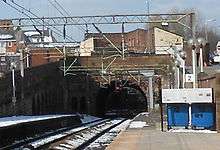Daylighting (tunnels)
Daylighting a tunnel is to remove its "roof" of overlying rock and soil, exposing the railway or roadway to daylight and converting it to a railway or roadway cut. Tunnels are often daylighted to improve vertical or horizontal clearances—for example, to accommodate double-stack container trains or electrifying rail lines, where increasing the size of the tunnel bore is impractical.
List of daylighted tunnels
- New Zealand
- The railway line through the Manawatu Gorge, when constructed in 1891, had five tunnels. Three of these were daylighted in 2008 to allow for the carriage of large containers (the other two tunnels had their floors lowered).[1]
- United Kingdom
- Liverpool Lime Street station was originally approached through a 1.13-mile (1.82 km) twin-track tunnel completed in 1836. The tunnel was daylighted in the 1880s, and replaced with a deep four-track cutting, with only the eastern 50 metres (55 yd) approaching Edge Hill railway station remaining as a tunnel.

The short remaining portion of Liverpool's Lime Street Station tunnel can be seen west of Edge Hill Station.
- United States of America
- Auburn Tunnel on the Schuylkill Canal, daylighted in 1857
- Tunnel No. 5 on the Alaska Railroad's Seward-Anchorage line[2]
- Tunnel No. 5 on the Virginia & Truckee Railroad at Nevada S.R. 341 near Virginia City
- The Gwynedd Cut on the North Pennsylvania Railroad, near North Wales, Pennsylvania, built as a tunnel between 1853 and 1856, daylighted in 1930 when the Reading Railroad electrified the line
- A number of tunnels were open cut for the National Gateway project including:
- Shoo Fly Tunnel (2012)
- Pinkerton Tunnel (2012)
- Benford Tunnel (2012)
gollark: Over 15 seconds on the usual common words dictionary so hardly very representative.
gollark: Huh. 86WPM with autocorrect, actually.
gollark: Due to phone bad.
gollark: If I did a typing test on my phone I'd only get 40WPM or something.
gollark: I'm on my phone. This would work very poorly.
See also
References
- The Encyclopedia of New Zealand: Daylighting a Manawatū Gorge tunnel
- F. C. Weeks et al., "Tunnel 'Daylighting' on the Alaska Railroad," Transportation Research Record No. 1119, Geotechnology (1987).
This article is issued from Wikipedia. The text is licensed under Creative Commons - Attribution - Sharealike. Additional terms may apply for the media files.